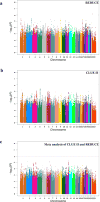A genetic variant near GATA3 implicated in inherited susceptibility and etiology of benign prostatic hyperplasia (BPH) and lower urinary tract symptoms (LUTS)
- PMID: 28656603
- PMCID: PMC5565164
- DOI: 10.1002/pros.23380
A genetic variant near GATA3 implicated in inherited susceptibility and etiology of benign prostatic hyperplasia (BPH) and lower urinary tract symptoms (LUTS)
Abstract
Background: Benign prostatic hyperplasia (BPH) and associated lower urinary tract symptoms (LUTS) are common conditions. Little is known about their etiologies except that studies have suggested a substantial heritable component. Our objective is to provide a comprehensive, genome-wide evaluation of inherited risks and possible mechanisms of etiology in BPH.
Methods: We performed a three-stage, genome-wide association study (GWAS) of men from three independent populations, the REduction by DUtasteride of prostate Cancer Events (REDUCE) trial, the CLUE II cohort, and a Finnish hospital-based population. DNA samples were genotyped using the Illumina HumanOmniExpress BeadChip in REDUCE and CLUE II, and using the Sequenom iPLEX system for the confirmation stage in the Finnish population. A logistic regression model was used to evaluate the association between each SNP and BPH/LUTS.
Results: Fourteen SNPs reached P < 5.0 × 10-4 in the meta-analysis of the two GWASs (CLUE II and REDUCE). A total of 773 SNPs were chosen for the confirmation step in the Finish cohort. Only one SNP (rs17144046) located ∼489 kb downstream of GATA3 remained significant after correction for multiple testing (P < 6.5 × 10-5 ). This SNP marginally reached the GWAS significance level after performing a meta-analysis of the three stages (P-meta = 8.89 × 10-7 ). Expression quantitative trait loci (eQTL) analyses showed that the risk allele (G) of rs17144046 was significantly associated with increased expression of GATA3 (P = 0.017). Reported studies indicated a close correlation between GATA3 and BPH pathogenesis and progression.
Conclusions: Rs17144046 located near GATA3 was significantly associated with BPH/LUTS in three independent populations, but did not reach a stringent GWAS significance level. Genetic variants of GATA3 may play a role in the inherited susceptibility and etiology of BPH/LUTS. Further research in this area is needed.
Keywords: BPH; LUTS; genome-wide association study.
© 2017 Wiley Periodicals, Inc.
Conflict of interest statement
No known conflict of interest is related to the study
Figures



Similar articles
-
Genome-wide associations for benign prostatic hyperplasia reveal a genetic correlation with serum levels of PSA.Nat Commun. 2018 Nov 8;9(1):4568. doi: 10.1038/s41467-018-06920-9. Nat Commun. 2018. PMID: 30410027 Free PMC article.
-
Does Prostate Size Predict the Development of Incident Lower Urinary Tract Symptoms in Men with Mild to No Current Symptoms? Results from the REDUCE Trial.Eur Urol. 2016 May;69(5):885-91. doi: 10.1016/j.eururo.2015.12.002. Epub 2015 Dec 24. Eur Urol. 2016. PMID: 26724841
-
Sexually transmitted infections, benign prostatic hyperplasia and lower urinary tract symptom-related outcomes: results from the Prostate, Lung, Colorectal and Ovarian Cancer Screening Trial.BJU Int. 2016 Jan;117(1):145-54. doi: 10.1111/bju.13050. Epub 2015 Apr 23. BJU Int. 2016. PMID: 25601300 Free PMC article.
-
Critical analysis of the relationship between sexual dysfunctions and lower urinary tract symptoms due to benign prostatic hyperplasia.Eur Urol. 2011 Oct;60(4):809-25. doi: 10.1016/j.eururo.2011.06.037. Epub 2011 Jun 29. Eur Urol. 2011. PMID: 21726934 Review.
-
Burden of male lower urinary tract symptoms (LUTS) suggestive of benign prostatic hyperplasia (BPH) - focus on the UK.BJU Int. 2015 Apr;115(4):508-19. doi: 10.1111/bju.12745. Epub 2014 Oct 16. BJU Int. 2015. PMID: 24656222 Review.
Cited by
-
Identification of novel plasma proteins as potential therapeutic targets for benign prostatic hyperplasia: a proteome-wide association study.Transl Androl Urol. 2025 Jun 30;14(6):1679-1690. doi: 10.21037/tau-2025-187. Epub 2025 Jun 23. Transl Androl Urol. 2025. PMID: 40687641 Free PMC article.
-
Association between vitamin D receptor gene polymorphisms and genetic susceptibility to benign prostatic hyperplasia: A systematic review and meta-analysis.Medicine (Baltimore). 2024 Mar 1;103(9):e37361. doi: 10.1097/MD.0000000000037361. Medicine (Baltimore). 2024. PMID: 38428858 Free PMC article.
-
Single-Nucleotide Polymorphism-Based Genetic Risk Score and Patient Age at Prostate Cancer Diagnosis.JAMA Netw Open. 2019 Dec 2;2(12):e1918145. doi: 10.1001/jamanetworkopen.2019.18145. JAMA Netw Open. 2019. PMID: 31880795 Free PMC article.
-
Role of CYP17 rs743572 Polymorphism in Benign Prostatic Hyperplasia: A Multivariate Integrated Analysis.Front Physiol. 2019 Jun 21;10:774. doi: 10.3389/fphys.2019.00774. eCollection 2019. Front Physiol. 2019. PMID: 31293443 Free PMC article.
-
A Novel Proteomics Approach to Identify Serum and Urinary Biomarkers and Pathways that Associate with Lower Urinary Tract Symptoms in Men and Women: Pilot Results of the Symptoms of Lower Urinary Tract Dysfunction Research Network (LURN) Study.Urology. 2019 Jul;129:35-42. doi: 10.1016/j.urology.2019.03.014. Epub 2019 Mar 25. Urology. 2019. PMID: 30922973 Free PMC article.
References
-
- Barry MJ. Epidemiology and natural history of benign prostatic hyperplasia. Urol Clin North Am. 1990;17(3):495–507. - PubMed
-
- Nickel JC. The economics of medical therapy for lower urinary tract symptoms associated with benign prostatic hyperplasia. Curr Urol Rep. 2006;7(4):282–287. - PubMed
-
- Wilson JD. The pathogenesis of benign prostatic hyperplasia. Am J Med. 1980;68(5):745–756. - PubMed
Publication types
MeSH terms
Substances
Grants and funding
LinkOut - more resources
Full Text Sources
Other Literature Sources
Medical

